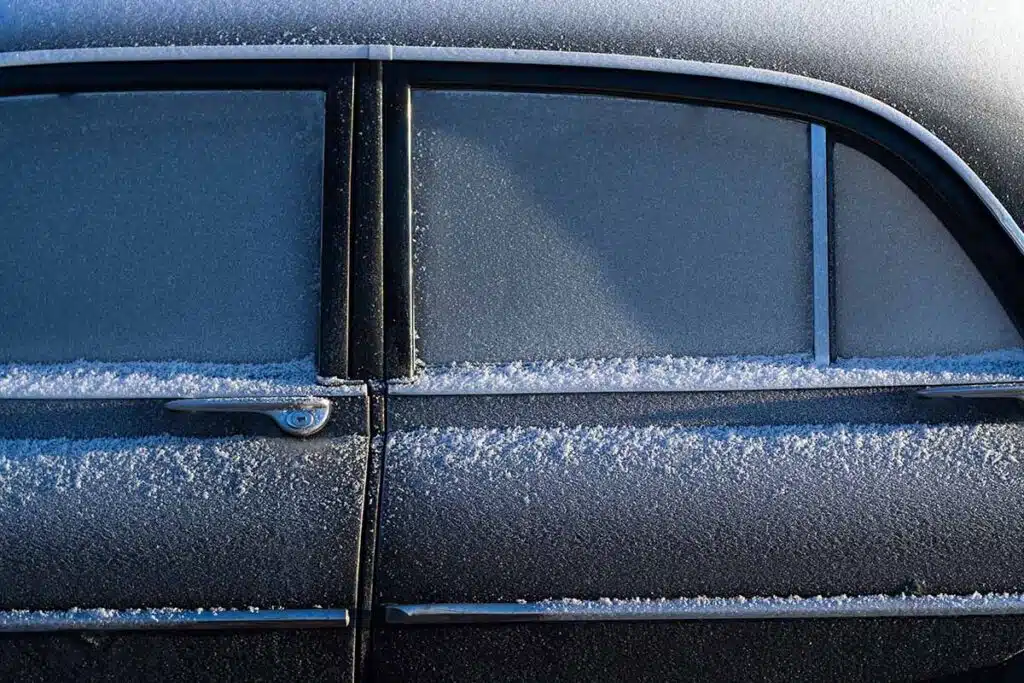Whether or not you are in a hurry, no one wants to deal with defrosting car windows first thing in the morning. This sentiment is especially true when the weather is extremely fickle or freezing cold.
Having a crystallized windshield and rearview mirrors sometimes cannot be helped, which is why knowing how to defrost car windows is of the essence.
Here are steps on how to defrost your car windows fast:
- Put your car heater on its highest setting.
- Keep A/C on.
- Turn off the Air Recirculation mode.
- Crack your window (even if only a bit).
- Turn the fan and temperature on high.
- Set your climate control system to Fresh-Air mode.
- Switch on your windshield wipers.
- Finally, defrost your windows.
Most of the time, choosing the right settings and balancing cabin and ambient temperatures are all there is to restoring visibility through your car windows and windshield.
But sometimes, a defogging solution or car defroster is necessary. In either situation, knowing how to defrost car windows will come in handy. And today’s article is just the information reference you need!

What Causes Your Car Windows to Frost?
A drop in temperature is the main reason your car windows frost or fog up. And it does not matter whether you have your vehicle parked in or out of the garage.
When it suddenly rains after a hot day, for instance, you will notice water droplets forming on the surface of the glass — more so when it is snowing. As such, you can expect your surroundings to start looking like paintings of Van Gogh.
Essentially, fog is water condensation, and frost is frozen fog. And how fast it forms is contingent on the degree of humidity and air temperature. The more hot and dry the air is, the more it can hold water vapor.
That said, your objective when using a car defroster (view on Amazon) or defogging your car windows and windshield by other means is to make the air around the glass as hot and dry as possible. So in the next section, I will outline easy-to-follow steps to make this feat possible.
How to Defrost Car Windows
Depending on your vehicle’s make and model, defrosting all your car windows with a single button may or may not be doable. Because instead of a button, most car models require a slew of knobs and switches to serve the same function.
Especially when you’re in a rush to get somewhere, fidgeting through these controls could prove a hassle when your only concern is how to defrost your car windows the fastest.
1. Put Your Car Heater on Its Highest Setting.
Using the defroster setting in your vehicle, crank your car heater all the way to help get rid of excessive moisture inside the cabin. This setting automatically engages your A/C plus a high fan speed and directs warm, dry air to the affected windshield and car windows.
There is an extra defroster in cars — a rear window defroster. You will want to turn that on to speed up the defogging process.
2. Keep A/C On.
Although it seems counter-intuitive, doing this will pull moisture out of the air faster as air passes through the cold coils in your car’s air conditioning system. This consistent draw of fresh air from the atmosphere helps with dehumidification.
After which, the dehumidified air passes through the heater core (view on Amazon) and converts to hot air to be blown out through the vents and onto the front windshield.
3. Turn off the Air Recirculation Mode.
This step is quite self-explanatory. Because you need to defog/defrost your car windows and windshield the quickest way possible, a consistent flow of fresh air entering your cabin is warranted.
But why do it? When Air Recirculation mode is on, your car uses water-vapor-filled air inside and around your vehicle instead of the potential dryer air outside. In no way does this help increase absorption capacity and offset the presence of saturated air inside your cabin.
4. Crack Your Window (Even if Only a Bit).
This is the other half of step #3, aimed at exchanging humid air inside your vehicle with drier air outside at a faster rate. However, this step may not be possible during sub-zero or rainy weather.
According to Autoweek’s Robin Warner, these initial four steps are the “optimal combination of settings” equivalent to pressing the defrost button in cars. However, he also emphasized that results will vary depending on ambient temperature and your vehicle.
If we were to take the easiest route in defrosting car windows, we would stop here. But to satisfy the goal of this guide, I will add a few more steps to this procedure.
5. Turn the Fan and Temperature on High.
For some vehicle owners, this is an extra step that comes after blasting the car heater.
Again, this may not be necessary for your car, depending on its make and model. But if you have these settings, it would be better to use them to dry frost more rapidly.
6. Set Your Climate Control System to Fresh-Air Mode.
Since Fresh-Air mode is the opposite of Air Recirculation mode, you already know what function it serves.
An optional step, it is necessitated only if you are adjusting your vehicle’s climate control system manually. Failure to do this will worsen the frost condition.
7. Switch on Your Windshield Wipers.
This step applies more to defogging car windows in summer than during freezing or rainy weather.
8. Finally, Defrost Your Windows.
It is a separate process and needs to be done immediately after the first seven steps detailed in this section. However, you cannot use a dry chamois to do this last step.
Instead, use a homemade alcohol solution (1 part water: 2 parts Isopropyl or rubbing alcohol) to wipe off your windshield and car windows. Keeping a spray bottle of this no-freeze solution in your glove compartment will come in handy whenever you are stranded.
Ideally, you should apply the solution on your windows and windshield before you drive off to prevent fogging or frosting throughout the day (if not, keep it to a minimum).
How to Defrost Car Windows While Driving

There are two ways to do this within the safety of your vehicle — you use either a defogger/defroster built into your car or a secondary defogger. Incredulous as it may seem, there is a distinct difference between the two. And mind you, they are not available in all car models.
A secondary defogger works on the principle of electric heating and is not integrated into the controls of your vehicle. How it works is that a “heating element is pasted on the glass surface to help defog the windshield.”
When activated, an electric current passes through the filaments of the heating element, producing heat. The heat, in turn, melts condensate, clinging to the glass surface.
On the other hand, a car defogger/defroster is activated via a button found on the dashboard that lights up when pressed. This button typically has an arrow-resembling icon.
When turned on, hot air passes through the air vents and goes toward the windshield to clear fog or frost. To deactivate the function after use, press its button for the second time.
Most vehicles have only one defogger button, while others have two — one each for the front and rear windshields. Inspect your dash panel to see if you have both.
How to Defrost Car Windows in Summer
As established earlier, a temperature drop causes fogging of the glass on your vehicle. It can happen in hot or cold weather. If you wonder how this is possible, the answer lies in your cabin temperature.
During winter or inclement weather, the outside air is colder than the inside of your vehicle. As a result, the inside of your windshield and car windows fog up.
The reverse is true during summer — the outside air is hotter than the inside of your cabin, causing the outer surfaces of your car glass to have water droplets or turn opaque. Given their inverse proportionality, you will need to balance the temperatures inside and outside your vehicle to clear up any fog or frost forming on the windshield and windows.
This balancing act involves three steps, as follows:
- In defogging car windows during summer, increase the A/C temperature until it matches the outside air.
- Switch on your windshield wipers to get rid of condensation on the outside glass.
- Roll the windows all the way down to demist glass surfaces and even out the inside and outside temperatures.
Other Hacks for Defogging Your Car Windows
Several online publications advise using the following unorthodox remedies:
- Kitty litter in a sock to help absorb moisture inside the cabin
- Silica balls in sock for moisture absorption
- Anti-fog window treatment like Rain-X 630046 Interior Glass Anti-Fog – 12 fl. oz. (view on Amazon)
- Shaving cream (works as well as a car window defogger!)
Additionally, they strongly suggest heeding the following tips:
While defrosting your car windows, refrain from rubbing a cloth on the windshield. Doing so can result in streaks that can hinder visibility through the windshield when driving toward headlights or when there is direct sunlight.
When turning the A/C on, experienced vehicle owners sometimes suggest matching the A/C temperature to that of the outside. However, this may not be the best action to take if the outside temperature is too low. Nonetheless, this is one way to defog car windows during winter or in the rain using AC.
Worst-case scenario, roll down the car windows if you want to defog or defrost them without using heat, A/C, or defoggers. This way, less-humid air enters the cabin and helps demist the windshield and car windows.
The only downside to this workaround is that it is almost impossible to do when it rains heavily. Not so much for winter as snow is frozen and technically results in dryer air compared to rainy weather when air is still saturated.
A Word to the Wise:
Never pour hot water on your cold windshield and car windows. It will not only be futile but also damaging to the glass surfaces. The worst that could happen is your windshield chipping or cracking (similar to how cutting marble looks) due to the sudden temperature change.
Conclusion – How to Defrost Car Windows

In summary, here are the eight tips on how to defrost car windows fast:
- Put your car heater on its highest setting.
- Keep A/C on.
- Turn off the Air Recirculation mode.
- Crack your window (even if only a bit).
- Turn the fan and temperature on high.
- Set your climate control system to Fresh-Air mode.
- Switch on your windshield wipers.
- Finally, defrost your windows.
Sometimes, rolling down your windows and driving al fresco is all it takes to get rid of the fog. But in most cases, more steps are necessitated.
Thankfully, clearing the fog or frost on your windshield and car windows is far from being a Herculean task. All you need is a sound working knowledge of the procedure and lots of patience to get the job done.
Kris is an avid off-roader and outdoor enthusiast who loves to brave the elements and take on challenging terrain. He also enjoys sharing his passion and knowledge with others so that they, too, can appreciate the ride.
About Kris
